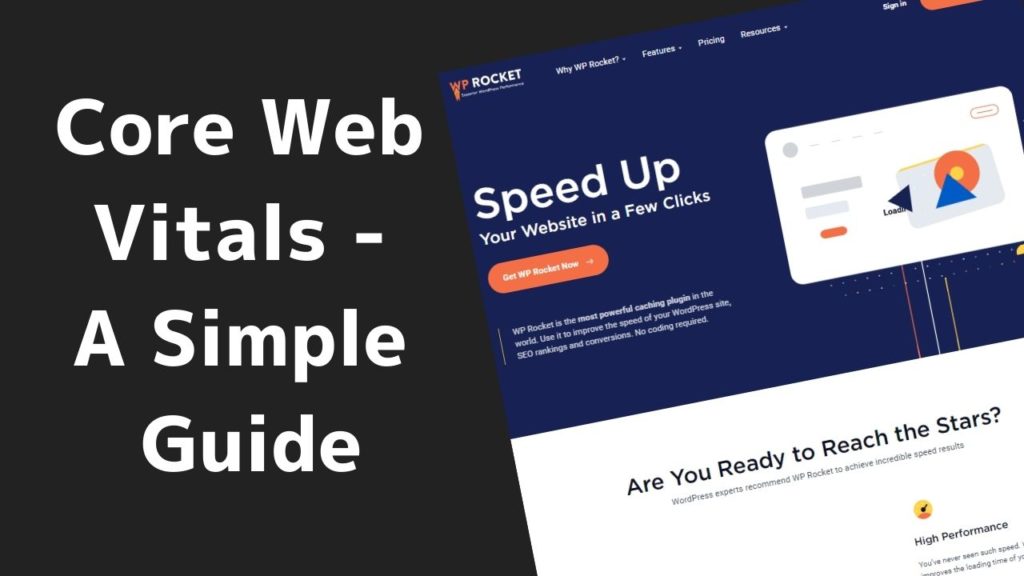Google has announced that site speed is an official part of their algorithm. This means that if your website takes too long to load it will be ranked lower in Google’s results. Site speed has been tied to the length of time a user views a search result. The faster your site loads, the better chance you have at being viewed by that user who clicks.

Table of Contents
Google has formalized site speed into standardized metrics calling these web vitals with a subset called Core Web Vitals which now form part of their algorithm.
Most people who want to pass core web vitals actually want SEO and better rankings so we’ve created this guide to be as practical as possible using the techniques we’ve developed optimizing 4000+ websites.
While the content here is targeted towards WordPress sites the same concepts apply to all platforms including Shopify.
The 3 Core Web Vitals Metrics & What They Are
There are several metrics your site needs to pass in order to get a passing Core Web Vital grade from Google. Some are more impactful than others. The most critical ones are:
LCP (Largest Contentful Paint)- The Largest Contentful Paint metric measures when the main content of the page has loaded. This is an important metric to users because it marks the point in the page load timeline when the user can determine if the page is useful or not.
FID (First Input Delay)- The First Input Delay metric measures the time between when a user interacts with the page and the time they see feedback. This is an important metric to users because it measures the responsiveness of the page.
CLS (Cumulative Layout Shift)- The Cumulative Layout Shift metric measures how often users experience unexpected layout shifts. A low CLS helps ensure that the page is stable and ready to interact with.
Other Important Web Vitals Metrics
There are other web vitals metrics that are important, but not as critical as the three mentioned above. They include:
TTFB (Time to First Byte)- The Time to First Byte metric measures how long it takes for the server to send the first byte of data. This is an important metric that is solely related to server performance and not directly related to front-end web development.
FCP (First Contentful Paint)- The First Contentful Paint metric measures when the first bit of content (not necessarily the main content) has loaded. This is an important metric because it marks the point in the page load timeline when some content is available.
We will go over the steps you can take to improve each of the above metrics later on in the article. But first, I want to make sure you understand how they work and how to measure them.
Understanding Core Web Vitals

Before you start implementing changes to your website, it’s important that you understand how Core Web Vitals work and how they impact your SEO.
28 Day Cycle Time- Any changes you make to your website will take time to be reflected in the search engine results. Google runs on a 28-day cycle, and it will take approximately that long for your changes to have an impact on your Core Web Vital scores.
The 28-day cycle makes it crucial to focus on the factors that have the greatest impact on your scores such as LCP, FID, and CLS. You can make small adjustments later once you begin seeing improvements in the metrics.
All Pages Matter (Not just the homepage)- Google isn’t just measuring the home page of your website. They are measuring all the pages on your website. This means that you need to make sure that all your pages and posts are fast, responsive, and stable.
You will also need to make sure any changes you make to your site are implemented on your product pages as well. This becomes especially important if you have a Shopify or WooCommerce site that sells products or services.
Real World Speed (RUM vs. Synthetic Monitoring)- While the results from synthetic monitoring tools can be helpful, Google Core Web Vitals are based on real-world user data. This means that you need to make sure your website is fast and responsive for actual users, not just simulated tests.
You can do this by using a real user monitoring tool such as SiteSpeedBot or Sematext Experience. RUM tools will passively monitor your website and record the behavior of actual users on your site. These tools will also analyze the data and give you insight into the speed and responsiveness of your website to help you understand the areas that need the most improvement.
All Locations Matter- Searchers from all over the world use Google, not just those in your country. This means that you need to make sure that your website is fast and responsive no matter where the user is located.
You can use the SiteSpeedBot tool to test the speed and responsiveness of your website from all over the world. This will help you understand where you need to make improvements so that no matter where the user is, they will have a positive experience on your website.
Measuring Core Web Vitals
It’s important to first measure your website’s core web vitals in order to identify areas of improvement.

You can use the following tools to do this:
CrUX Report, which has been around since 2017, is a public data set of Real User Measurements (RUM). It is updated daily with data from millions of actual Chrome users that have opted into sharing the data associated with the site they visited. You can check your sites CrUX report here!
The CrUX Report provides the following Core Web Vital Metrics:
- Largest Contentful Paint (LCP)
- First Input Delay (FID)
- Cumulative Layout Shift (CLS)
Google Search Console also provides insights into your site’s performance. You can find this under “Core Web Vitals”, within the “Experience” tab. The information is based on RUM data (Real User Measurement) from Chrome and shows the results for all valid pages on your website.
Google Search Console provides information on the following:
- Page Experience
- Core Web Vitals
- Mobility Usability
We recommend running several tests from different locations around the world in order to get a good idea of your site’s performance. The more data you collect, the more accurate your results will be.
Step by Step Guide to Fixing & Passing Core Web Vitals
Once you have enough data and have identified the areas of improvement, it’s time to start fixing them.
Overall Broad Improvements
The first thing you should do is check for any overall issues that will help your site load faster. This includes things like hosting and whether or not you’re using any CDN.
Upgrade Hosting:
Regardless of the improvements you make, your site will never reach its potential if you’re using a low-quality hosting provider. If your website is hosted on HostGator, Bluehost, or GoDaddy, it’s time to upgrade. These providers are known for overcrowded servers and poor performance.
Upgrading to a quality hosting provider will have the biggest impact on your Core Web Vitals.
We recommend using any of the following hosting companies:

WP Engine- WP Engine is a managed WordPress hosting provider that has been built from the ground up for speed and performance. They offer a suite of features to help you improve your website’s loading time, including caching, GZIP compression, and automatic WordPress updates.
CloudWays- CloudWays is a cloud hosting platform that allows you to host your website on a variety of different cloud providers, including Amazon Web Services (AWS), and Google Cloud Platform (GCP), and DigitalOcean. This gives you the ability to choose the provider that best suits your needs and budget.
SiteGround- SiteGround is a well-known WordPress hosting provider that offers a wide range of features, including caching, GZIP compression, and automatic WordPress updates. They operate on Google Cloud, which provides a powerful and highly advanced hosting service.
Kinsta- Kinsta also operates on the Google Cloud Platform and offers a range of features that help speed up your site, including Nginx, PHP 8.0, and LXD containers. They are ideal for e-commerce sites and heavy traffic websites.
Use a CDN:
Another improvement any site owner should implement to improve their Core Web Vitals is to use a CDN.
A Content Delivery Network (CDN) is an online platform that stores resources on multiple servers across the globe, so they can be delivered to users from the server that is closest to them. This helps improve the speed at which your site loads for people all over the world.
The most popular CDNs are Cloudflare and WP Rocket.
Cloudflare- Cloudflare is a CDN that secures, speeds up, and improves your website’s performance. It acts as a reverse proxy where all traffic passes through the Cloudflare network first before it hits your server. The benefits of this include caching static content, reducing HTML document size by removing unnecessary data from HTML pages, as well as using various security protocols to block common attacks.
WP Rocket- WP Rocket is a CDN plugin that speeds up your site and reduces page load times by caching static resources like CSS and JavaScript files and compressing HTML, JPEG, and PNG images. WP Rocket also includes various optimizations for WordPress users, such as blocking requests to known bad bots and crawlers.
Monitor Uptime:

A CDN is only as good as its uptime. If you’re experiencing downtime, it defeats the purpose of using one. Make sure to monitor your site’s uptime and make improvements to avoid any major service interruptions.
Implementing these broad improvements will help your site’s Core Web Vital metric scores, but there are also other things you can do to improve specific areas.
Reduce Page Weight (200k or less): Our Full Guide to Reduce Page Weight
- Resize and compress images
- Remove unused CSS & JavaScript
- Enable GZIP compression
- Remove Custom fonts
Reduce TTFB (less than 200 ms): Our Full Guide to Reduce TTFB
- Configure caching
- Use a fast host
- Optimize database
- Leverage browser caching
- Minify resources
- Enable HTTP/2
Improve FCP (below 1.8 sec): Our Full Guide to Improve FCP
- Enable caching
- Increase server resources
- Inline critical CSS
- Reduce DOM size
- Use fast ad serving solutions
Improve LCP (below 2.5 sec): Our Full Guide on Improving LCP
- Configure a CDN
- Serve images in next-gen format
- Use page caching
- Use a fast DNS host
Optimize FID (under 100 ms): Our Full Guide on Reducing Total Blocking Time
- Optimize JavaScript code
- Use web workers
- Defer JavaScript
- Serve static content
Eliminate CLS (below 0.1):
- Preload web fonts
- Specify width and height attributes on images
- Manage size for Ad slots
- Manage space for embeds and iframes
How Site Speed ACTUALLY Impacts SEO
Now that you understand the basics of Core Web Vital scores, it’s important to understand why Google is focusing on Speed and how it impacts your SEO.
Google’s main goal is to provide the best search experience for its users. That means providing relevant results as quickly as possible so that searchers don’t have to wait too long before finding what they need on your site.
Speed also impacts user engagement and retention rates which can negatively impact your revenue streams and lead generation efforts. A slow-loading website can lead to a poor user experience and ultimately, them leaving your site. This will leave a bad impression on the search engine that recommended your website resulting in lower rankings and visibility.
Here are Three Ways to Address Common Problems with Site Speed
1- Get Faster Hosting
One of the quickest and most effective ways to speed up your website is to switch to a faster hosting provider. The right host can make a dramatic difference in the speed of your website.
If you’re hosting your site with a cheap hosting provider, it’s likely to be sharing resources with thousands of other sites. This can cause your website to run slowly since you have to compete for server resources.
Upgrading to a faster host may cost you a bit more in the short run, but it will be worth it in the long run. It directly affects the LCP, TTFB, and FCP and will improve your overall Core Web Vital Score.
Your site will also benefit from improved Uptime and Reliability, which are both critical for any site that generates revenue and leads. Visitors can’t signup or make a purchase if your site is down and search engines have been known to demote sites that have unstable and poor uptime.
2- Page Size is Everything (Page Weight)
The size of your web pages is critical to how quickly they load. The speed at which a page loads is directly proportional to the weight of the page which is in turn, proportional to its size.
WordPress is a great platform for beginners and seasoned developers alike, but it comes with a lot of bloat. Over time, your site will get even more bloated as you add more and more plugins, themes, images, and videos.
This is especially true if your site suffers from any of the following:
- Outdated Plugins- A plugin that is no longer being updated by its developers is a ticking time bomb for your website. These plugins can have security vulnerabilities that are not fixed and can cause your site to crash or worse, be hacked.
- Unused Themes- If you’re not using a theme, delete it. Themes take up unnecessary space and can leave behind a ton of bloat from demo images, CSS files, and scripts.
- Uncompressed Images- Images can be compressed without any noticeable quality loss. Compressing your images will reduce the file size and the overall size of the page.
- Not Lazy-Loading Videos and Images- If you implement lazy-loading for your videos and images, it will only load them when they are visible on the screen. This will reduce the number of bytes that need to be loaded on the initial page load.
3. CrUX Data and User Experience
Contrary to what some believe, Google wants your site to be successful! They provide many tools that will help you improve your site experience and ultimately, increase your rankings. One of those tools is the Chrome User Experience Report.
The CrUX report provides a wealth of data that can be used to identify common problems with page speed. You can use this data to not only see where you have areas of improvement but also the areas you are excelling in.
Although the improvements you make to your site will be reflected in the CrUX report. It will take some time for the data to be collected and analyzed. So, don’t expect instantaneous results.
On average, Core Web Vitals updates every 28-30 days so you will need to be patient while waiting for your score to reflect the changes.
Regardless of the changes you make, if you skip the previous two recommendations, Get a Fast Host and Reduce Page Size, all of your efforts will be wasted!
Final Thoughts
Remember, Core Web Vitals is all about making sure your site runs its best, not just for the search engines but also for your visitors. As with most SEO changes, the impact of these may not be seen immediately, but over time, as you make the necessary changes, you will see an improvement in your overall score.
Now that you understand the basics of Core Web Vitals, it’s time to put them into practice and start making your site faster and more user-friendly!
By following the recommendations in this article, you will be well on your way to improving your Core Web Vitals score and your site’s overall speed and performance.